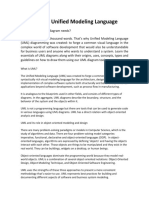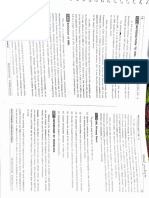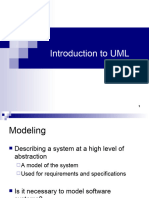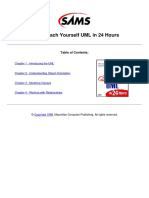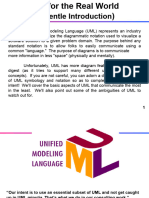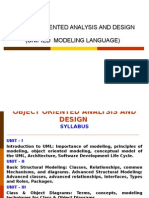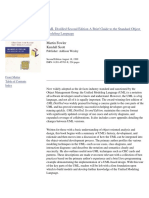0 ratings 0% found this document useful (0 votes) 85 views 6 pages UML Fundamentals
The Unified Modeling Language (UML) is a standardized modeling language used to specify, visualize, and document software systems, particularly large enterprise applications. UML 2.0 introduces enhancements such as nested classifiers and improved behavioral modeling, allowing for better abstraction and representation of complex systems. It supports various methodologies and can be utilized across different programming languages and platforms, making it a versatile tool for software development.
Copyright
© © All Rights Reserved
We take content rights seriously. If you suspect this is your content,
claim it here .
Available Formats
Download as PDF or read online on Scribd
Go to previous items Go to next items
Save UML Fundamentals For Later 9128/24, 1:53 PM ‘What is UML | Unified Modeling Language
INTRODUCTION to one's unirieo mone.ine LANGUAGE (UML®)
UNIFIED
MODELING ®
LANGUAGE...
(Updated July 2005 to reflect formal adoption of UML 2.0 Superstructure}
Large enterprise applications - the ones that execute core business applications, and keep @ company going - must be
more than just a bunch of code modules. They must be structured in a way that enables scolability, security, and robust
execution under stressful conditions, and their structure - frequently referred to as their architecture - must be defined
clearly enough that maintenance programmers can (quickly!) find and fix a bug that shows up long after the original
‘authors have moved on to other projects. That is, these programs must be designed to work perfectly in many areas,
‘and business functionality is not the only one (although it certainly is the essential core]. Of course o well-designed
architecture benefits any program, and not just the largest ones as we've singled out here. We mentioned large
applications first because structure is a way of dealing with complexity, so the benefits of structure (and of modeling
‘and design, as we'll demonstrate) compound as application size grows large. Another benefit of structure is that it
enables code reuse: Design time is the easiest time to structure an application as a collection of self-contained
modules or component:
Eventually, enterprises build up a library of models of components, each one representing an
implementation stored in a library of code modules. When another application needs the same functionality, the
designer can quickly import its module from the library. At coding time, the developer can just as quickly import the
code module into the application.
Pitpsswww.umlorgiwhas-um him 16�728/24, 153 PM ‘Whats UML | Unified Modeling Language
Modeling is the designing of software applications before coding, Modeling is an Essential Part of large software
projects, and helpful to medium and even small projects as well. A model plays the analogous role in software
development that blueprints and other plans (site maps, elevations, physical models) play in the building of a
skyscraper. Using a model, those responsible for a software development project's success can assure themselves thot
business functionality is complete and correct, end-user needs are met. and program design supports requirements for
scalability, robustness, security, extendibility, and other characteristics, before implementation in code renders changes
difficult and expensive to moke. Surveys show that large software projects have a huge probability of foilure - in fact,
it's more likely that a large software application will fail to meet all of its requirements on time and on budget thon that
it will succeed. if you're running one of these projects, you need to do all you can to increase the odds for success, and
modeling is the only way to visualize your design and check it against requirements before your crew starts to code
RAISING THE LEVEL OF ABSTRACTION
Models help us by letting us work at a higher level of abstraction. A model may do this by hiding or masking details,
bringing out the big picture, or by focusing on different aspects of the prototype. In UML 2.0, you can zoom out from a
detailed view of an application to the environment where it executes, visualizing connections to other applications or,
zoomed even further, to other sites. Alternatively, you can focus on different aspects of the application, such as the
business process that it automates, or a business rules view. The new ability to nest model elements, added in UML.
2.0, supports this concept directly
‘The OMG's Unified Modeling Language" (UML®) helps you specity, visualize, and document models of software
systems, including their structure and design, in a way that meets all of these requirements, (You can use UML for
business modeling and modeling of other non-software systems too.) Using any one of the large number of UML-
based tools on the market, (httpsu/ww.omg.orgiuml-directory/) you can analyze your future application's
requirements and design a solution that meets them, representing the results using UML 2.0's thirteen standard
diagram types.
You can model just about any type of application, running on any type end combination of hardware, operating
system, programming language, and network, in UML. Its flexbilt lets you model distributed applications that use just
‘about any middleware on the market. Built upon fundamental OO concepts including class and operation, it's a natural
fit for object-oriented languages and environments such as C++, Java, and the recent Ci, but you can use itto model
non-O0 applications as wellin, for example, Fortran, VB, or COBOL. UML Profiles (that's, subsets of UML tailored for
specific purposes) help you model Transactional, Real-time, and Fault-Tolerant systems in a natural way.
YOU CAN DO OTHER USEFUL THINGS WITH UML T00
For example, some tools analyze existing source code (or, some claim, object codel) and reverse-engineer it into a set
of UML diagrams, Another example: Some tools on the market execute UML models, typically in one of two ways:
‘Some tools execute your model interpretively in a way that lets you confirm that it really does what you want, but
without the scalability and speed that you'll need in your deployed application. Other tools (typically designed to work
only within a restricted application domain such as telecommunications or finance) generate program language code
from UML, producing most of a bug-free, deployable application that runs quickly if the code generator incorporates
best-practice scalable patterns for, eg, transactional database operations or other common program tasks. (OMG
members are working on a specification for Executable UML now.) Our final entry in this category: A number of tools
on the market generate Test and Verification Suites from UML models.
Pitpsswww.umlorgiwhas-um him 216�9128/24, 1:53 PM ‘What is UML | Unified Modeling Language
UML AND OMG'S MODEL DRIVEN ARCHITECTURE® (MDA®)
‘A few years ago (in fact, surprisingly few!) the biggest problem a developer faced when starting a distributed
programming project was finding a middleware with the functionality that he needed, that ran on the hardware and
‘operating systems running in his shop. Today. faced with an embarrassingly rich array of middleware platforms, the
developer has three different middleware problems: First, selecting one; second, getting it to work with the other
platforms olready deployed not only in his own shop, but also those of his customers and suppliers; and third,
interfacing to (or, worse yet, migrating to) a new "Next Best Thing” when a new platform comes along and catches the
fancy of the analysts and, necessarily, CIOs everywhere.
With its rich palette and middleware independence, UML forms a foundation of OMG's Model Driven Architecture®
(MDA@) (https:/lwww.omg.orgimdal). In fact, a UML model can be either platform-independent or platform-specific, as
we choose, and the MDA development process uses both of these forms: Every MDA standard or application is based,
normatively, on a Platform-independent Model (PIM), which represents its business functionality and behavior very
precisely but does not include technical aspects. From the PIM, MDA-enabled development tools follow OMG-
standardized mappings to produce one or more Platform-Specific Models (PSMs}, also in UML, one for each target
platform that the developer chooses. (This conversion step is highly automated, but not magic: Before the tool
produces a PSM, the developer must annotate the base PIM to produce a more specific but still platform-independent
PIM that includes details of desired semantics, and guides choices that the tool will have to make, Because of the
similarities among middleware platforms of a given genre - component-based, or messaging-based, for example - this
guidance can be included in a PIM without rendering it platform-specific. Still, developers will have to fine-tune the
produced PSMs to some extent, more in early days of MDA but less and less as tools and algorithms advance.)
‘The PSM contains the same information as an implementation, but in the form of a UML model instead of running
code. In the next step, the tool generates the running code from the PSM, along with other necessary files (including
interface definition files if necessary, configuration files, makefiles, and other file types). After giving the developer an
‘opportunity to hand-tune the generated code, the tool executes the makefiles to produce a deployable final
application,
MDA applications are composable: If you import PIMs for modules, services, or other MDA applications into your
development tool, you can direct it to generate calls using whatever interfaces and protocols are required, even if these
run cross-platform, And, MDA applications are future-proof: When a new "Next Best Thing" comes on the market,
OMG members will generate and standardize a mapping to it, and your vendor will upgrade his MDA-enabled tool to
include it. Taking advantage of these developments, you will be able to generate cross-platform invocations to the new
platform, and even port your existing MDA applications to it, automatically using your existing PIMs.
MODELS VS. METHODOLOGIES
‘The process of gathering and analyzing an application's requirements, and incorporating them into a program design,
is a. complex one and the industry currently supports many methodologies that define formal procedures specifying
how to go about it. One characteristic of UML - in fact, the one that enables the widespread industry support that the
language enjoys - is that it is methodology-independent. Regardless of the methodology that you use to perform your
analysis and design, you can use UML to express the results, And, using XMI® (XML™ Metadata Interchange, another
(OMG standard) (nttp:/iwww.omg.orgispec/XMI/), you can transfer your UML. model from one tool into @ repository, or
into another tool for refinement or the next step in your chosen development process. These are the benefits of
standardization!
Pitpsswww.umlorgiwhas-um him 36�9128/24, 1:53 PM ‘What is UML | Unified Modeling Language
WHAT CAN YOU MODEL WITH UML?
UML 2.0 defines thirteen types of diagrams, divided into three categories: Six diagram types represent static
‘application structure; three represent general types of behavior; and four represent different aspects of interactions:
> Structure Diagrams include the Class Diagram, Object Diagram, Component Diagram, Composite Structure
Diagram, Package Diagram, and Deployment Diagram,
> Behavior Diograrrs include the Use Case Diagram (used by some methodologies during requirements gathering);
Activity Diagram, and State Machine Diagram,
> Interaction Diagrams, all derived from the more general Behavior Diagram, include the Sequence Diagram,
‘Communication Diagram, Timing Diagram, and interaction Overview Diagram.
‘We don't intend this introductory web page to be a complete UML tutorial, so we're not going to list any details of the
different diagram types here. To learn more, you can check out one of the many on-line tutorials (resource-hub. htm), or
buy a book. (The last time we checked, typing "UML" into the search box for the major on-line booksellers returned a
list of more than 100 titles!) Or, if you're technical and want the whole story, you can download the UML specification
itself (https:/hwww.omg.org/spec/UML/) from the OMG website. It's free, of course, but it's also highly technical, terse,
‘and very difficult for beginners to understand.
FM ABOUT TO START MY FIRST UML-BASED DEVELOPMENT PROJECT. WHAT DO I NEED TO D0?
Three things, probably (but not necessarily) in this order:
Select c methodology: A methodology formally defines the process that you use to gather requirements, analyze
them, and design an application that meets them in every way. There are many methodologies, each differing in
some way or ways from the others, There are many reasons why one methodology may be better than another for
your particular project: For example, some are better suited for large enterprise applications while others are built to
design small embedded or safety-critical systems. On another axis, some methods better support large numbers of
architects and designers working on the same project, while others work better when used by one person or a
small group
OMG, as a vendor-neutral organization, does not have an opinion about any met
jodology.
2. Select c UML Development Tool: Because most (although not all) UML-based tools implement a particular
methodology, in some cases it might not be practical to pick a tool and then try to use it with @ methodology that it
wasn't built fr. (For other toolimethadology combinations, this might not be an issue, or might be easy to work
round) But, some methodologies have been implemented on multiple tools so this is not strictly a one-choice
environment.
You may find a tool so well-suited to your application or organization that you're willing to switch methodologies in
order to use it. f that's the case, go ahead - our advice to pick a methodology fist is general, and may not apply to
a specific project. Another possibilty: You may find a methodology that you like, which isn't implemented in a tool
that fits your project size, or your budget, so you have to switch. If either of these cases happens to you, try to pick
4an alternative methodology that doesn't differ too much from the one you preferred originally
‘As with methodologies, OMG doesn't have an opinion or rating of UML-based modeling tools, but we do have links
to a number of lists here (https:/www.omg org/um|-directory/}. These will help you get started making your choice.
Pitpsswww.umlorgiwhas-um him 46�9128/24, 1:53 PM ‘What is UML | Unified Modeling Language
Get Training: You and your staff (unless you're lucky enough to hire UML-experienced architects) will need training
in UML, It's best to get training that teaches how to use your chosen tool with your chosen methodology, typically
provided by either the tool supplier or methodologist. Once you've learned UML, you can become an OMG-certified
UML Professional - check here for details (https:/inww omg.orgjcertification/um))
UML 2.0 - A MAJOR UPGRADE
The "Available" version of the UML 2.0 Superstructure specification (that is, the version that has finished its first
maintenance release and been built into vendor products) has been completed, and is available to everyone for free
download. Three separate parts of UML 20 - the Infrastructure (that is, the meta-metamodel}, Object Constraint
Language, and Diagram Interchange - are still undergoing their first maintenance and will become Available
Specifications when this completes. There's a description of the current state of all four specifications, and links to all of
them, here (resource-hub.htm).
WHATS NEW IN UML 2.0
We've already integrated the new features into this writeup. but here's a summary:
> Nested Classifiers: This is an extremely powerful concept. In UML, almost every model building block you work
with (classes, objects, components, behaviors such as activities and state machines, and more) is a classifier. In
UML 2.0, you can nest a set of classes inside the component that manages them, or embed a behavior (such as a
state machine) inside the class or component that implements it. This capability also lets you build up complex
behaviors from simpler ones, the capability that defines the Interaction Overview Diagram. You can layer
different levels of abstraction in multiple ways: For example, you can build a model of your Enterprise, and zoom
in to embedded site views, and then to departmental views within the site, and then to applications within a
department.
> Improved Behavioral Modeling: in UML. 1.X, the different behavioral models were independent, but in UML 2.0,
they all derive from a fundamental definition of a behavior (except for the Use Case, which is subtly different but,
Stil participates in the new organization),
> Improved relationship between Structural ond Behavioral Models: As we pointed out under Nested Classifiers,
UML 2.0 lets you designate that a behavior represented by (for example} a State Machine or Sequence Diagram
is the behavior of a class or a component.
‘That is, the new language goes well beyond the Classes and Objects well-modeled by UML 1.X to add the capability to
represent not only behavioral models, but also architectural models, business process and rules, and other models,
used in many different parts of computing and even non-computing disciplines,
During the upgrade process, several additions to the language were incorporated into it, including the Object
Constraint Language (OCL) and Action Semantics.
Pitpsswww.umlorgiwhas-um him�9128/24, 1:53 PM ‘What is UML | Unified Modeling Language
CUSTOM LINKS
‘About Us (https:www.omg.org/aboutlindex htm)
Contact Us (httpsv/ivww.omg.orgieontact.htm)
Site Map (https:/www.omg orgi/site-map.htm)
ABOUT US
‘The OMG® is an international not-for-profit software consortium that is setting standards in the area of distributed
‘object computing, We are a vendor-neutral membership-driven organization and have hundreds of members who are
working towards developing and refining these standards. See our Member List search page
(https:fiwww.omg.orgicgi-bin/appsimembersearch pl) if you want to find out if a company is a member. Our Board of
Directors (https:/fwww.omg.org/board-of directors htm) includes prominent and influential members who act as
visionaries who shape the direction of the organization.
LEARN MORE (HTTPS://WWW.OMG.ORG/MEMBERSERVICES/INDEX HTM)
CONTACT US
‘9C Medway Road, PMB 274
Milford, MA 01757 USA
& Telephone: +1-781-444-0404
Fax: +1-781-444-0320
%__info@omgorg (mailto:info@omg.ora)
Copyright © 2024 Object Management Group®, Ine. (httpsumww.omgorgiindexhtm) | All Rights Reserved
B) GH) (8>LB Witter comlobjectmamtgroup)
(nttpstittps vitor ttiteetlcomfeyamratiMla@iyiser/ObjectMgmtGrouph
Pitpsswww.umlorgiwhas-um him 86

